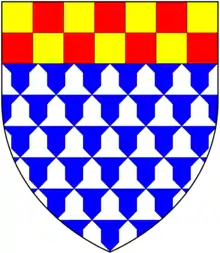Erchenbald or Archembald was a mesne lord listed in the Domesday Book of 1086 as a tenant of nine manors in Devon and Cornwall, England. He is believed to be the first English ancestor of the prominent Fleming family.
Landholdings
The Domesday book records that Erchenbald held three manors in Cornwall and six in Devon, all as tenant of Robert, Count of Mortain,[1] who was a half-brother of William the Conqueror and held over one hundred west country manors as tenant-in-chief.
Erchenbald's landholdings recorded in the Domesday Book are as follows.
In Cornwall:
- Brea, Cornwall (in Connerton Hundred)
- Avalde, Cornwall (in Fawton Hundred)
- Bodbrane, Cornwall (in Fawton Hundred)
In Devon:[2]
- Culleigh, in the parish of Frithelstock in Shebbear hundred, Devon;
- Alverdiscott, in Fremington Hundred, Devon;
- Bratton, in Braunton Hundred, Devon, today known as Bratton Fleming;
- Croyde, in the parish of Georgeham, in Braunton Hundred, Devon
- Hele, Devon (probably in Meeth parish)
- Stockleigh, Devon (Meeth parish, Shebbear Hundred)
He was also recorded as holding livestock (five cattle & eight sheep) in the manor of Weare (Giffard), Devon, which was held from Robert Count of Mortain by Roald Dubbed.
Fleming family

Erchenbald is assumed to be the first English ancestor of the family surnamed "Fleming", of Bratton Fleming. He came to England during the reign of William the Conqueror (1066-1087) and was a follower of that king's uterine half-brother Robert, Count of Mortain. He was succeeded by his son, Stephen (fl. 1145),[4] whose son, "Erchenbald son of Stephen" occurs as holder of several knight's fees in Devon and Cornwall in the 1166 Liber Niger ("Return of the Barons"). He went to Ireland with Henry II in 1171 and participated in Hugh de Lacy's plantation of the Kingdom of Mide. Succeeding Flemings were Stephen, died c. 1213 – 1214 and Baldwin, died 1260.
The lands of Robert, Count of Mortain, became the core holdings of the feudal barony of Launceston,[5] in Cornwall, and the Fleming family continued to hold most of their manors from that barony, as can be seen from entries in the Book of Fees (c.1302) – for example, Baldwin le Flemeng is listed as holding lands in Crideho (Croyde) and also in Bratton' cum membris ("with its member (estates)"), both by then fees held from the feudal barony of Launceston. Baldwin also held Alverdiscott, and held Benton and Haxton, from the feudal barons of Bradninch.[6]
A later descendant, Simon Fleming (died 1370) became the first Baron Slane.
References
- ↑ Thorn, Caroline & Frank, (eds.) Domesday Book Vol. 9: Devon. Part 2, 15,11. Note: not in the printed edition of 1985, but included in version 1a of the Devon Notes, downloadable as an rtf file from a link on https://hydra.hull.ac.uk/resources/hull:535
- ↑ Thorn & Thorn, Devon Notes. 15,11; 39-41; 47; 54.
- ↑ Lysons, Daniel and Samuel (1822). "General history: Families removed or extinct by 1620". British History Online. Retrieved 9 February 2019. (page clxv in the original)
- ↑ Madox's Hist, of the Exchequer, i. 543
- ↑ Sanders, I.J., English Baronies, Oxford, 1960, p.60
- ↑ Thorn, Caroline & Frank (Eds.), Domesday Book, Vol.9, Devon, Chichester, 1985, Vol.2, chap. 15,40-41
Further reading
- Fleming, F. Lawrence, A Genealogical History of the Barons Slane, Paragon Publishing, Rothersthorpe, 2008
- Fleming, F. Lawrence, The Norman Family of Fleming: Researching the Norman Ancestry of the Fleming Family, "published on the internet", 2009
- Fleming, F. Lawrence, A Genealogy of the Ancient Flemings, Paragon Publishing, Rothersthorpe, 2010